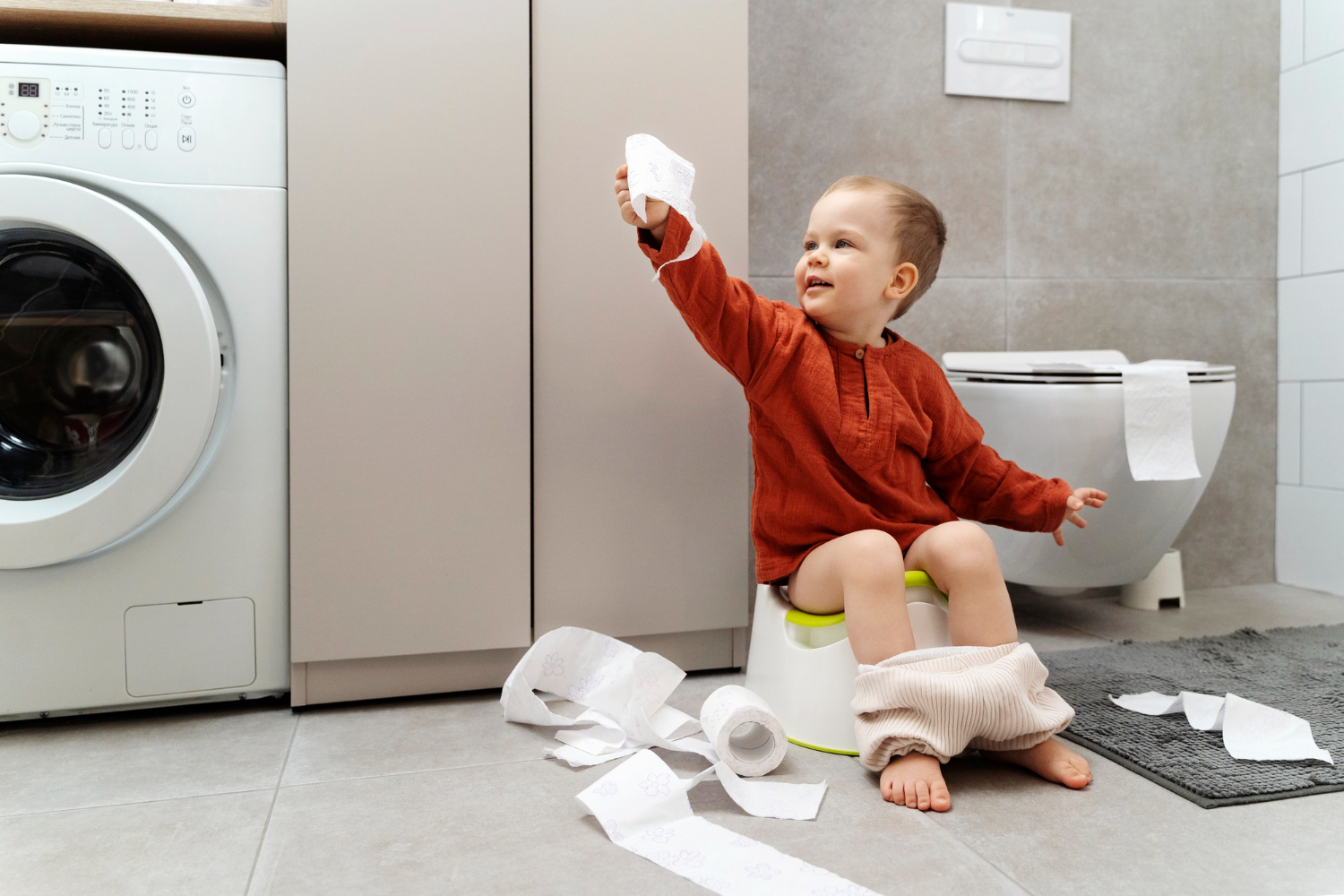Potty training is an exciting milestone in a child’s development, but it can also be a daunting experience for both parents and toddlers. While every child is unique, there are some specific considerations when it comes to potty training boys. From the timing to the techniques, it’s important to find a strategy that works for both you and your son.
This article will provide you with practical tips, step-by-step guidance, and useful advice on potty training boys. We’ll cover when to start, how to tackle common challenges, and tips for making the process as smooth as possible.
When Should You Start Potty Training Your Boy ?
One of the most common questions parents ask is : When is the right time to start potty training? There’s no one-size-fits-all answer, as every child develops at their own pace. However, most boys are ready to start potty training between 2 and 3 years of age. Some children may show signs of readiness earlier, while others might need a little more time.
Here are some common signs that your son might be ready for potty training :
- Dry periods : If your child stays dry for longer periods (2-3 hours at a time), it’s a good indication that their bladder control is improving.
- Interest in the toilet : Your son may show interest in using the potty or watching others use the toilet.
- Communication : If your child can communicate when they need to go (through words or gestures), they’re likely ready to start potty training.
- Discomfort with dirty diapers : Boys often become more aware of a wet or dirty diaper and may show discomfort or ask to be changed.
- Following instructions : Potty training requires your child to follow basic instructions, so if they can follow simple tasks like “sit down” or “stand up,” they might be ready to start.
Tip : Don’t rush the process. If your child isn’t ready, forcing them can lead to frustration for both of you. Waiting until your son shows signs of readiness will make the experience more positive and successful.
Step-by-Step Guide to Potty Training for Boys
Potty training can be more complex for boys since they need to learn both sitting and standing techniques. However, by following these simple steps, you can help your son master potty training.
Step 1 : Introduce the Idea of Potty Training
Before diving into the actual training, it’s important to introduce your child to the concept of using the potty. Start by talking about what the toilet is for and how it’s used. You can also let your child observe you or older siblings using the bathroom.
Ways to introduce potty training :
- Read books about potty training: There are many children’s books that explain the process in a fun and engaging way. Choose one with colorful pictures to keep your son interested.
- Use potty training videos : Some children respond well to videos that show other kids using the potty.
- Let him explore the potty : Let your child sit on the potty with their clothes on at first to get comfortable with the idea.
Step 2 : Choose the Right Equipment
Having the right equipment can make potty training easier and more fun for boys. There are two main options when it comes to choosing a potty :
- Potty Chair : A small, child-sized chair that sits on the floor. It’s easy for your son to sit down and get back up, and the familiarity can help build confidence.
- Potty Seat Insert : This fits on top of a regular toilet seat, reducing its size so your child doesn’t feel like they might fall in. A step stool may be needed for him to reach the toilet.
Tip : Let your son choose the potty chair or seat insert to give him a sense of ownership in the process.
Step 3 : Start with Sitting
It’s generally recommended to begin potty training boys by having them sit on the potty. This allows them to focus on both peeing and pooping without the confusion of learning to stand right away.
Start by having him sit on the potty first thing in the morning, before bedtime, and after meals. You can also encourage sitting on the potty when you notice signs that he needs to go, such as squatting or holding his diaper.
Making Potty Training Fun for Boys
Potty training doesn’t have to be a stressful experience—it can actually be a fun and rewarding time! Here are some creative ways to make potty training an enjoyable process for your son:
1. Offer Positive Reinforcement
Positive reinforcement is a powerful tool when potty training. Celebrate every success, no matter how small, to keep your son motivated and excited.
- Stickers or Charts : Create a potty chart and let your child add a sticker every time they use the potty. Once they collect a certain number of stickers, reward them with a small prize.
- Praise : Simple praise like “Good job!” or “I’m proud of you” goes a long way in making your child feel accomplished.
- Small Treats : Some parents find that offering small treats, such as a favorite snack, can help encourage their child to use the potty regularly.
2. Use Potty Training Games
Boys often enjoy games, so why not make potty training a game too? If your son is learning to pee standing up, you can turn it into a fun challenge by using toilet targets.
- Toilet Targets : You can buy special flushable toilet targets or make your own by throwing a few Cheerios into the toilet bowl and encouraging your son to aim at them.
- Time Challenges : Set a timer and see if your child can make it to the potty before the timer goes off. This helps create urgency in a playful way.
3. Make It a Routine
Establishing a potty routine can help reinforce the habit. Take your son to the potty at regular intervals, such as every two hours, before leaving the house, and after naps or meals.
Create consistency in the routine by making it part of your daily schedule. Eventually, your child will start to recognize when they need to go, and the routine will help prevent accidents.
Standing vs Sitting : When to Teach Boys to Stand
As boys get more comfortable with potty training, it’s natural to wonder when to teach them to stand while urinating. Most experts recommend starting with sitting for both peeing and pooping, as it simplifies the process.
Once your son is confident and consistent with sitting, you can introduce standing for peeing. Here’s how you can teach him :
- Demonstrate : Many boys learn by watching their father or an older brother. Show him how to aim and explain the importance of lifting the toilet seat and aiming into the bowl.
- Use a Step Stool : A small step stool can help your child reach the toilet comfortably. Make sure he feels stable and confident while standing.
- Encourage Practice : Practice makes perfect! Give your child plenty of opportunities to try standing and aim, and use games like toilet targets to make it fun.
Tip : Don’t rush the transition to standing. Some boys may prefer to sit for longer, and that’s perfectly fine. Let him progress at his own pace.
Handling Common Potty Training Challenges
Every parent encounters some obstacles during potty training, but understanding how to handle these challenges can make the process easier.
1. Resistance to the Potty
If your son is showing resistance to using the potty, it could be a sign that he’s not quite ready yet. Pushing too hard can lead to anxiety and delay progress. Take a step back and try again in a few weeks.
Tip : Keep the potty training process positive and avoid punishments or negative comments if he has accidents or resists.
2. Fear of Pooping
Some boys may become anxious about pooping in the potty, especially if they’ve had a painful bowel movement in the past. Encourage your child to sit on the potty when they feel the urge to poop, and offer comfort and reassurance.
Tip : Make sure your child is getting enough fiber and staying hydrated to prevent constipation, which can contribute to fear of pooping.
3. Nighttime Potty Training
Daytime potty training usually comes before nighttime training. It’s common for boys to take longer to stay dry at night, as bladder control during sleep develops later.
Tip : Use nighttime pull-ups or training pants until your son consistently wakes up dry. Limit liquids in the evening and make sure he uses the potty before bed.
Conclusion
Potty training for boys can be a smooth and rewarding process when approached with patience, consistency, and a bit of creativity. By following the steps outlined in this article, introducing the concept early, making the process fun, and using positive reinforcement, you can help your son master potty training.
Remember that every child is different, and it’s important to go at your child’s pace. Celebrate successes, handle setbacks with understanding, and soon enough, your son will be confidently using the potty on his own.
Happy potty training!




